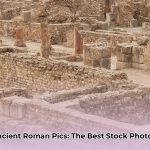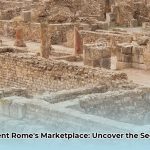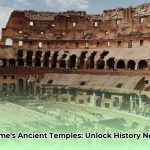Ancient Rome, a beacon of civilization and unparalleled influence, profoundly shaped the foundations of our modern world. Learn more about Rome’s history for detailed insights. Stepping onto the hallowed ground of these historic sites allows for a tangible connection to the past, offering insights that transcend mere textual descriptions. These magnificent structures and social hubs are not simply collections of aged stones; they resonate with the echoes of emperors, gladiators, and everyday citizens, providing a vivid window into a bygone era. Through exploring these architectural marvels and centers of power, we gain a deeper appreciation for the ingenuity, societal complexities, and enduring legacy of the Roman Empire, a civilization that spanned across much of Europe, North Africa, and the Middle East, leaving an indelible mark.
Iconic Landmarks: The Pillars of Roman Grandeur
No journey to the Eternal City is truly complete without experiencing its most celebrated ancient Roman landmarks. These sites are not just tourist attractions; they are powerful testaments to Roman ambition, engineering, and cultural impact.
The Colosseum: An Arena of Power and Spectacle
The Colosseum, formally known as the Flavian Amphitheater, stands as Rome’s most enduring symbol, an awe-inspiring monument to Roman engineering and societal control. Completed in 80 AD, this monumental arena could seat between 50,000 and 80,000 spectators, making it the largest amphitheater ever built. Beyond the popular image of gladiatorial combat, the Colosseum hosted a diverse array of public spectacles, including staged animal hunts (venationes) featuring exotic beasts from across the empire, highly realistic mock naval battles (naumachiae) for which the arena floor was flooded, and elaborate dramas based on classical mythology.
The engineering ingenuity behind its construction is staggering. Its sophisticated system of ramps, trapdoors, and lifts underneath the arena floor (the hypogeum) allowed for the dramatic entrance of animals and gladiators, transforming the spectacle. A retractable canvas awning, the velarium, provided shade for the audience, operated by a complex system of ropes and pulleys manned by hundreds of sailors. These games, while providing entertainment, also served as a critical means of social control, diverting the attention of the masses from challenging political issues and subtly reinforcing the emperor’s power and benevolence. Here, the magnificent ambition and inherent brutality that characterized Roman society for centuries converged. What profound lessons about human nature and governance might these ancient stones still impart to us today?
The Roman Forum: The Pulsating Heart of an Empire
The Roman Forum, now an extensive network of captivating ruins, once served as the bustling epicenter of Roman daily life, politics, and religion. Within its sacred boundaries, political debates raged, solemn religious ceremonies unfolded, and vibrant commerce thrived. Here, crucial decisions were forged, significant laws were proclaimed, and the very fate of the Roman Empire was frequently determined.
Imagine senators, draped in their distinctive togas, passionately arguing their points in the Curia Julia (Senate House), skilled orators captivating the throng with their eloquence from the Rostra, and energetic merchants eagerly hawking their various wares along the Via Sacra. Key structures included the Temple of Vesta, where Vestal Virgins tended the sacred flame, and the imposing Arch of Septimius Severus, commemorating military victories. Ongoing archaeological excavations tirelessly continue to uncover new, fascinating layers of history, often providing fresh perspectives on even the most well-known historical events and continually refining our understanding of this pivotal public space.
The Pantheon: An Enduring Architectural Masterpiece
The Pantheon, with its awe-inspiring, unreinforced concrete dome, stands as a remarkable testament to Roman architectural prowess and has been miraculously preserved over the centuries. Completed around 126 AD, this extraordinary feat of Roman engineering continues to inspire profound awe and wonder in all who behold it, seamlessly blending functionality with aesthetic grandeur. Originally constructed as a temple dedicated to all the gods, it was later meticulously converted into a church in the 7th century, a transformation that likely played a crucial, safeguarding role in protecting it from the widespread devastation that befell many other ancient structures.
The Pantheon’s dome, a perfect hemisphere with a central oculus (open eye to the sky), remains the largest unreinforced concrete dome in the world. Its ingenious construction utilized progressively lighter aggregates in the concrete as the dome rose, minimizing weight. This architectural innovation profoundly influenced subsequent generations of architects, including Brunelleschi for the Florence Cathedral and Michelangelo for St. Peter’s Basilica. Inside, the Pantheon has served as the burial place for many notable figures, including the Renaissance painter Raphael. It certainly begs a deeper question: what other architectural wonders did they conceive and construct that have, unfortunately, been lost to the relentless march of time and the forces of nature?
Palatine Hill: The Legendary Birthplace and Seat of Power
According to deeply ingrained Roman mythology, Palatine Hill marks the very spot where Rome, the Eternal City, was born – the place where Romulus himself, the mythical founder, first established the nascent city. Concrete archaeological evidence reveals early habitation dating back to the 10th century BC, solidifying its profound place in Rome’s formative history. The foundational myth of Romulus and Remus, miraculously suckled by a she-wolf in the Lupercal cave on the Palatine, inextricably links the hill directly to the city’s origin story, imbuing it with spiritual importance.
Over centuries, it majestically evolved into an exclusive residential area, highly favored by powerful emperors and the city’s wealthiest aristocrats. During the flourishing Roman Republic, it became the highly coveted neighborhood of choice for Rome’s elite and influential citizens. As Rome transitioned into a sprawling Empire, powerful emperors like Augustus deliberately chose the Palatine as their primary residence, transforming it into an impressive and extensive imperial palace complex. This significant shift reflected the undeniable centralization of power into the hands of a single, omnipotent individual. The very word “palace” directly derives from the Palatine Hill, underscoring its historical significance as a seminal seat of power and luxury.
A leisurely and contemplative walk through its evocative ruins provides a truly captivating glimpse into the opulent and luxurious lifestyles enjoyed by Rome’s elite during its imperial peak. You can vividly visualize the lavish, sprawling villas of the House of Augustus and the House of Livia, their walls adorned with vibrant frescoes, and the monumental Domitian’s Palace, designed by the master architect Rabirius. Ongoing archaeological digs on the Palatine constantly unearth new and intriguing artifacts, adding further intricate details to our ever-expanding understanding of this immensely important historical location and continuously reshaping our understanding of the Palatine, challenging previous interpretations and offering compelling new insights.
Ostia Antica: A Glimpse into Roman Daily Life and Trade
For a distinctly different perspective on ancient Rome, consider embarking on a highly worthwhile excursion to Ostia Antica, which served as the city’s bustling ancient port. Unlike the grand, imposing monuments found in the urban heart of the capital, Ostia Antica offers a more intimate and remarkably relatable look into the daily routines and lives of ordinary Roman citizens. Founded strategically in the 4th century BC, it served as the indispensable linchpin for extensive trade, pivotal military operations, and the constant movement of people across the vast Mediterranean. Its strategic location at the mouth of the Tiber River ensured the efficient flow of goods, significantly boosting Rome’s economy and enriching its cultural landscape.
While Pompeii offers a singular moment frozen in time, Ostia Antica tells a different story. It reveals the gradual, dynamic evolution of Roman daily life and urban planning across many centuries. The remarkably well-preserved ruins provide a comprehensive view of sophisticated Roman urban design, from multi-story residential insulae (apartment buildings) like the House of Diana to lively commercial areas and grand public spaces. You can freely explore its remarkably well-preserved streets, once-bustling shops (such as the remarkably detailed laundries or fullonicae), and surprisingly sophisticated apartment buildings. The Piazzale delle Corporazioni (Square of the Corporations), with its intricate mosaics on the floor, acted as ancient advertisements, clearly indicating the origin or specialty of the merchants, linking the city to diverse regions spanning the entire Roman Empire. The Baths of Neptune, showcasing impressive mosaics, functioned as vibrant social hubs for relaxation, intellectual conversation, and communal engagement. This comprehensive preservation makes it an invaluable site for understanding Roman societal evolution. The city’s gradual decline, commencing in the 4th century AD, was due to the Tiber River’s heavy silting and the spread of malaria from increasing marshlands, leading to its eventual abandonment and rediscovery through 19th-century archaeological excavations.
Deeper Dives & Hidden Wonders: Beyond the Postcards
Beyond the universally famous landmarks, Rome holds a treasure trove of lesser-known yet equally captivating sites that are exceptionally well worth seeking out for the curious and adventurous explorer.
Baths of Caracalla: Imperial Leisure and Engineering Marvels
These once-opulent imperial bath complexes, inaugurated in 216 AD by Emperor Caracalla, offer a captivating glimpse into the elaborate social and recreational lives of ancient Romans. Imagine the intricate bathing rituals they performed, the communal exercises they enjoyed in the vast gymnasiums, and the lively conversations that filled the grand, echoing halls. These served as vital social hubs, not just places for hygiene. The complex included not only hot (caldarium), warm (tepidarium), and cold (frigidarium) baths, but also Olympic-sized swimming pools, libraries, art galleries, and manicured gardens. The baths were heated via an incredibly sophisticated underground oven system (hypocaust) that circulated hot air beneath the floors and through the walls. Even today, the scale of the remaining brick walls gives a magnificent impression of their former grandeur, once adorned with marble, mosaics, and monumental sculptures. Today, they are also a spectacular backdrop for summer opera performances.
Domus Aurea (Nero’s Golden House): A Palace of Excess
This lavish and infamous palace, commissioned and built by the flamboyant Emperor Nero after the Great Fire of Rome in 64 AD, is gradually being revealed to the modern world through ongoing archaeological excavations. Sprawling over an estimated 100-300 acres across the Palatine, Esquiline, and Caelian hills, its extravagant design and opulent decorations were legendary. The villa featured a revolving dining room, mosaic-covered ceilings with precious stones, and walls adorned with gold leaf and frescoes by the artist Famulus. The artificial lake on its grounds was later drained to make way for the Colosseum, a symbolic erasure of Nero’s unpopular excesses. Many parts remain unexplored, hinting at even greater discoveries. Through innovative virtual reality experiences, visitors can now immerse themselves in what this incredible complex would have looked like in its heyday.
Circus Maximus: The Chariot Racing Colossus
Once the largest stadium in ancient Rome, the Circus Maximus was primarily used for thrilling chariot races that could entertain up to 250,000 spectators. Its distinctive U-shape, dating from Julius Caesar’s time and expanded after the Great Fire of 64 AD, hosted Roman Games, gladiator fights, and animal hunts, becoming a central part of the city’s entertainment landscape. While little remains of its original structures today beyond the vast open oval space, its sheer size allows for vivid imagination of the roaring crowds, thundering hooves, and intense excitement of ancient races. Modern VR experiences, like the Circo Massimo Experience, beautifully overlay the ancient structure onto the current landscape, bringing its glory back to life.
The Appian Way (Via Appia Antica): Walking Through History
Built over 2,300 years ago, the Appian Way is one of Rome’s most authentic and best-preserved ancient roads. Some parts look much as they did in antiquity, lined with ancient family graves and mausoleums. This “queen of roads” connected Rome to Brindisi, serving as a vital military and commercial artery. Walking or biking along its original basalt stones allows one to easily imagine Roman legions marching, carriages rattling, and travelers journeying. It offers a magical escape from the modern city, providing a rare opportunity for quiet contemplation among truly ancient ruins.
Park of the Aqueducts (Parco degli Acquedotti): Roman Engineering Prowess
Located on the outskirts of Rome, this park showcases magnificent sections of ancient Roman aqueducts, fine examples of ancient engineering that brought fresh water from distant mountains into the burgeoning city. Aqueducts like the Aqua Claudia and Aqua Marcia stretched for tens of kilometers, built with precise, minute gradients to ensure constant water flow. Their towering arches stand as a testament to Rome’s advanced hydraulic engineering and their understanding of public health infrastructure. This serene park offers a chance to admire these structures without the crowds of central Rome, providing a peaceful environment for appreciation.
Largo di Torre Argentina: Caesar’s Fate and Feline Friends
This public square in Rome’s historic center is home to some of the city’s most ancient temples, dating from the 4th to 2nd centuries BC. It is famously recognized as the exact site where Julius Caesar was murdered by the members of the Roman Senate on the Ides of March (March 15) in 44 BC, adjacent to the ruins of the Theater of Pompey. Recently made accessible to the public via a walkway, visitors can now explore the ruins up close. Beyond its profound historical significance, Largo di Torre Argentina is also known for its large colony of stray cats, which have found a sanctuary among the ancient stones. Its blend of tragic history, ancient architecture, and unexpected charm makes it a uniquely Roman spot.
Trajan’s Market & Forum: The World’s First Shopping Mall
Trajan’s Market, often described as the world’s oldest shopping mall, was a vast, multi-level commercial and administrative complex built in the early 2nd century AD as part of Trajan’s Forum. Designed by Apollodorus of Damascus, it housed over 150 shops, offices, and even libraries, demonstrating the Romans’ sophisticated approach to urban planning and commerce. Walking on the original streets of ancient Rome, like Via Biberatica, within this complex provides a unique insight into the everyday life of Roman people and how the city evolved over centuries. The Museum of Imperial Fora within the market further enriches the experience, charting the history of Rome’s forums.
Castel Sant’Angelo (Mausoleum of Hadrian): From Tomb to Fortress
Once the tallest building in Rome, Castel Sant’Angelo initially served as the impressive mausoleum for Emperor Hadrian and his family, completed in 139 AD. Throughout its long history, it transformed from a tomb into a military fortress in the 5th century, and later a papal residence and prison. A fortified, elevated corridor, the Passetto di Borgo, connects it directly to the Vatican, famously used by popes as an escape route during sieges. Today, it functions as a museum, offering visitors a journey through centuries of Roman and papal history, with perfectly preserved frescoes, the Chamber of Ashes, and panoramic views of Rome and St. Peter’s Basilica from its Terrace of the Angel.
Roman Catacombs: Ancient Underground Burial Sites
For a unique and somber perspective on early Roman life and religion, a visit to one of Rome’s ancient catacombs, subterranean tunnel systems used for burials, is highly recommended. Over 60 known catacombs, stretching for hundreds of kilometers, exist beneath the city. The Catacombs of St. Callixtus, located near the Appian Way, are among the largest and most famous, stretching for approximately 20 km and containing an estimated half a million graves, including those of several early popes and Christian martyrs. These sites provide invaluable insights into early Christian communities, their burial practices, and the transition from paganism to Christianity in ancient Rome. Access is typically with an official guide, offering a profound journey into the city’s hidden history.
Baths of Diocletian: The Largest Imperial Baths
Built between 298 AD and 306 AD, the Baths of Diocletian were the largest and most luxurious public bath complex in ancient Rome, capable of accommodating over 3,000 citizens. This colossal structure, covering an area of 13 hectares, was a marvel of engineering, featuring vast bathing halls, open-air swimming pools, gymnasiums, and libraries. Unlike the ruins of Caracalla, much of the Diocletian complex was repurposed over the centuries; parts were converted into a basilica by Michelangelo (Santa Maria degli Angeli e dei Martiri), and a monastery. Today, the site houses the National Roman Museum – Baths of Diocletian section, displaying an extensive collection of ancient Roman artifacts, sculptures, and mosaics, offering a comprehensive look at the daily life and artistic achievements of the Roman Empire.
Theatre of Marcellus: A Public Entertainment Venue
Often dubbed the “mini-Colosseum” due to its architectural resemblance, the Theatre of Marcellus was the largest and most important theatre in ancient Rome, capable of seating up to 20,000 spectators. Construction began under Julius Caesar and was completed by Emperor Augustus in 12 BC, dedicated to his nephew Marcellus. This open-air theatre remained in use until the 4th century. Like many ancient Roman buildings, it was later repurposed, serving as a fortress in the Middle Ages and later as an apartment building, with luxury residences still occupying its upper tiers today. The archaeological site itself is a museum and sometimes hosts concerts, offering a unique blend of ancient history and modern life.
The Pyramid of Cestius: An Egyptian Mystery in Rome
Looking somewhat out-of-place and totally different from anything else in Rome, the Pyramid of Cestius (Piramide di Caio Cestio) is one of the oldest and best-preserved landmarks in the city. Built between 18 and 12 BC as a mausoleum for Gaius Cestius, a wealthy Roman magistrate, its Egyptian style reflects the fascination with ancient Egypt that swept through Rome after its conquest. The pyramid survived for over 20 centuries mainly because it was integrated into the city’s defensive Aurelian Walls during the 3rd century AD. While typically admired from the outside, its unique presence underscores the diverse cultural influences and far-reaching connections that profoundly shaped the Roman Empire.
Preserving the Past for the Future: A Shared Responsibility
The preservation of Rome’s ancient landmarks is a crucial and continuous undertaking that necessitates the concerted efforts of a wide range of stakeholders, all diligently working together to safeguard this invaluable cultural heritage for countless generations to come. This collective guardianship ensures that the wonders of Roman history remain accessible and inspiring.
| Stakeholders | Short-Term (0-1 Year) | Long-Term (3-5 Years) |
|---|---|---|
| Tourists | Explore less crowded, alternative sites to mitigate visitor impact on fragile locations; Utilize readily available virtual tours to reduce direct foot traffic on sensitive areas, minimizing wear and tear; Adhere strictly to site rules, including “do not touch” policies and designated pathways. | Actively participate in sanctioned archaeological volunteer programs or contribute financially to reputable archaeological digs and long-term preservation initiatives, directly aiding in the conservation of cultural heritage; Advocate for responsible tourism practices and engage in educational outreach. |
| Educators/Researchers | Develop engaging and highly informative online educational resources, utilizing high-resolution images, interactive elements, and virtual reality experiences to broaden access to ancient civilization knowledge; Integrate current archaeological findings into curricula to keep learning dynamic and relevant. | Collaborate on interdisciplinary research projects to further our scientific understanding of Roman history and to develop innovative, sustainable preservation techniques and materials that can withstand environmental degradation; Publish findings in open-access journals to ensure wide dissemination of knowledge and encourage further study. |
| City Planners/Preservationists | Implement sustainable tourism strategies that minimize the environmental and structural impact of tourism on ancient sites, while actively promoting responsible visitation practices and visitor education on fragile historic sites; Conduct regular, proactive structural assessments and urgent repairs. | Secure consistent and substantial funding streams for crucial long-term preservation projects, ensuring the ongoing maintenance, meticulous restoration, and protective measures for Rome’s irreplaceable ancient landmarks, vital for future generations to experience Imperial Rome; Develop comprehensive management plans that balance public access with conservation needs and integrate climate resilience. |
Rome’s ancient landmarks are far more than just compelling relics of a distant past; they serve as invaluable










